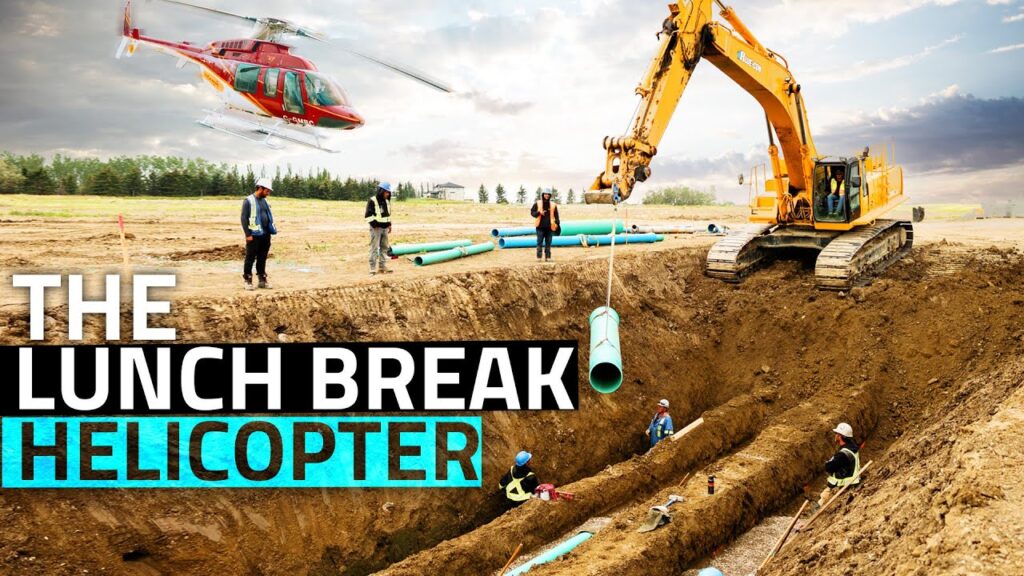The Role of Construction Crew Helicopter Transport in Mexico’s Infrastructure
In the sprawling landscapes of Mexico, the development of infrastructure is both a necessity and a challenge. With a terrain that includes vast deserts, rugged mountains, and dense forests, the traditional modes of transporting construction crews can be inefficient and sometimes impossible. This is where helicopter transport has emerged as a vital solution. Helicopters offer the ability to quickly move personnel to and from remote or difficult-to-reach job sites, thereby significantly accelerating project timelines and optimizing manpower.
Efficiency and Accessibility are at the forefront of why helicopter transport has become integral to construction projects across Mexico. By circumventing the complexities of ground travel, such as traffic congestion and poor road conditions, helicopters provide swift access to sites that would otherwise consume valuable hours or days. Utilizing these aerial workhorses for ferrying crews not only reduces the transit time but also boosts the morale and productivity of workers by lessening their travel fatigue.
The adoption of aerial crew transport also ensures a higher level of safety in the transportation logistics of construction. Helicopters are capable of landing in confined spaces and can be deployed for emergency evacuations if necessary, offering a layer of security for the workforce against the myriad of onsite dangers. As Mexico continues to invest in its infrastructure, the role of helicopter transport in ensuring the efficient, safe, and timely completion of construction projects is likely to grow even more prominent.
Advantages of Using Helicopter Transport for Construction Projects
In the fast-paced world of construction, efficiency and timeliness are paramount. Utilizing helicopter transport for moving materials and equipment to various construction sites brings forth a plethora of significant advantages that are hard to ignore. One of the primary benefits is the ability to easily reach remote or difficult-to-access areas that traditional ground transportation might struggle with. Helicopters can land on rugged terrain, atop skyscrapers, or in confined spaces that would otherwise necessitate extensive groundwork to access. This can drastically cut down the time needed to commence a project and allows for construction in locations that are off the beaten path.
Increased Speed and Flexibility
Another advantage is increased speed and flexibility in logistics planning. Helicopter transport allows for quick delivery of materials directly to the exact location needed, bypassing common ground transport issues such as traffic delays or road construction. It also offers the flexibility to respond rapidly to changing circumstances, which can be crucial in keeping a construction project on schedule. For instance, when a critical piece of machinery breaks down, a replacement part or even a new piece of equipment can be airlifted to the site without significant delays, preventing costly downtime.
Minimized Environmental Impact
Moreover, helicopter transport can potentially reduce the environmental footprint of construction projects. Since helicopters can fly directly to a site, there’s a reduction in the need for creating temporary roads or clearing vast tracts of land. Furthermore, the reduced use of heavy trucks and other ground machinery helps minimize soil disruption and the overall environmental disturbance. Employing helicopters can streamline a construction project to be more environmentally sensitive while still achieving its objectives efficiently.
By considering these advantages, construction managers can appreciate the strategic value of helicopters. They not only provide a practical solution to logistical challenges but also foster a more efficient and environmentally considerate approach to construction.
Case Studies: Successful Helicopter Transports in Mexican Construction
Helicopter transportation in Mexico has been pivotal in advancing construction projects, especially in remote and challenging locations where traditional transportation is unfeasible. The geography of Mexico, which includes dense forests, rugged mountains, and various other natural obstacles, often necessitates the use of helicopters for efficient and safe transport of materials and personnel. These case studies highlight exceptional instances where helicopter transportation has significantly contributed to the successful completion of construction projects in Mexico.
In the construction of the Santa Maria Dam in Chihuahua, heavy machinery and materials needed to be transported over the Sierra Madre Occidental, a region known for its harsh terrain. Here, helicopters played an essential role by airlifting construction materials, which not only expedited the process but also ensured worker safety. The precision of aerial delivery allowed for the fast-paced construction, enabling the dam to be completed ahead of schedule and within budget constraints.
Another example is the expansion of telecommunications infrastructure in the state of Oaxaca. Due to the intricate and inaccessible terrain, deploying traditional ground transport was not a practical option for erecting cell towers. Helicopters were used to transport sections of towers and essential equipment to designated sites. This aerial approach minimized environmental impact and significantly reduced construction time, proving to be an innovative solution in logistical planning.
Additionally, in the urban setting of Mexico City, helicopters aided in the construction of one of its tallest skyscrapers, Torre Reforma. Considering the congested cityscape and limited space for ground cranes, helicopters were employed to lift heavy construction materials to the upper levels of the building during non-peak hours to avoid disruption. This strategy highlighted the helicopter’s role in urban construction, ensuring minimal interference with city life while adhering to tight project deadlines.
How Helicopter Transport Enhances Efficiency on Construction Sites
One of the primary benefits of utilizing helicopter transport in construction is the remarkable reduction in transit time for materials and personnel. Traditional ground transportation can often be hampered by unpredictable traffic, poor road conditions, and lengthy routes, especially in remote areas. Helicopters, on the other hand, can travel in a straight line directly to the site, significantly cutting down on delivery times and allowing for more rapid progression of construction projects.
Helicopters also provide unparalleled access to difficult-to-reach locations, such as high-rise structures or geographically isolated areas. These agile aircraft can land on small, improvised sites or even hover to unload cargo while airborne, bypassing the need for large clearances required for ground vehicles. This capability is particularly useful in urban settings where space is at a premium or in rugged terrain where traditional transport methods might not be feasible.
The flexibility of helicopter transport offers enhanced logistics coordination on construction sites. Helicopters can be deployed quickly and adapted to a variety of roles, from transporting heavy equipment to aerial surveying. This flexibility allows project managers to respond to changing needs and challenges in real-time, avoiding delays and maintaining the momentum of the construction process.
Despite the higher initial cost, helicopter transportation can lead to long-term savings by minimizing the downtime that can accrue from slower ground-based transportation methods. The speed and efficiency of a helicopter can result in faster project completion, which not only saves money in terms of labor and rental equipment but can also mean that the constructed facilities go into operation sooner, generating revenue more quickly.
Lastly, helicopters impart a minimal environmental footprint on the construction site compared to traditional vehicles. The reduced need for ground-clearing and road-building to accommodate transport vehicles means that helicopters can preserve the surrounding ecosystem, an ever-increasing concern in today’s environmentally-conscious industry. Furthermore, the reduction in ground traffic lessens the chance of soil compaction and other forms of environmental stress often associated with heavy machinery.
Safety Protocols for Helicopter Transport of Construction Materials
Hiring helicopters for the transportation of construction materials comes with unique safety challenges that require strict adherence to protocols. Ensuring the safety of both the crew and the material on board becomes paramount, as any negligence can result in severe consequences. The Mexican Aviation Authority has established comprehensive guidelines that helicopter operators must follow. Safety measures include thorough pre-flight planning, weight and balance calculation, and the securing of materials to prevent any shift during flight that might affect the stability of the aircraft.
Prior to transport, a meticulous inspection of helicopter and load equipment is mandatory. This includes checking for any mechanical issues that could jeopardize the flight and verifying the integrity of slings, nets, and other material-holding devices. It is critical that all materials to be transported are compatible with the helicopter’s lift capacity and that the center of gravity remains well within the permissible limits after loading. In Mexico, pilots are expected to have specialized training in vertical reference flying to enhance their ability to manage external loads safely.
Communication during these operations cannot be understated. Constant contact between the pilot, ground crews, and air traffic control is essential to maintain situational awareness. Weather conditions in Mexico can change rapidly, and pilots must be informed immediately of any changes that may affect the safety and operation of their flight. Staying informed of potential hazards like power lines, wind variations, and other aerial obstacles is critical for the successful and safe delivery of construction materials via helicopter.
Future of Aerial Construction Logistics in Mexico
The landscape of construction logistics in Mexico is on the brink of a significant transformation with the advent of advanced aerial technologies. The integration of helicopters in the transportation and delivery of materials to hard-to-reach sites promises to streamline operations and reduce delivery times. As remote and geographically challenging regions are being developed, these aerial solutions could very well become an industry standard in the years to come.
Moreover, the environmental impact of construction logistics is a growing concern, and the use of helicopters is poised to address this issue head-on. By providing a means to bypass ground-based obstacles and traffic, helicopters can reduce the carbon footprint associated with the traditional transportation of construction materials. This eco-friendlier approach not only supports Mexico’s green initiatives but also aligns with global sustainability trends.
Technological advancements in drone capabilities and autonomous flight are expected to augment the role of helicopters in the construction industry. With the potential for unmanned aerial vehicles (UAVs) to carry payloads, the prospect of more cost-effective and efficient delivery services is becoming a reality. This could dramatically change the scale and pace at which construction projects are undertaken in Mexico.
With a keen eye on safety and regulation, the Mexican government and private sector stakeholders are working collaboratively to create a framework that accommodates the use of these aerial vehicles. Ensuring the safe integration of helicopter logistics into Mexico’s bustling construction landscape remains a top priority, as does the need to develop skilled personnel to operate and manage these sophisticated machines.


